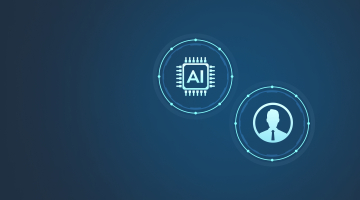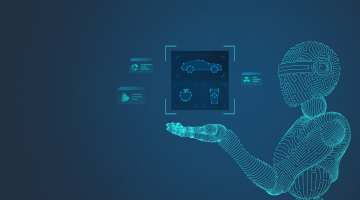
Types of AI models with examples: Complete overview for 2025
In the high-tech-driven business environment of the early third millennium, using artificial intelligence to perform specific tasks in enterprise settings is not a question of personal choice but a vital necessity for companies poised for big-time success. Organizations that fail to reinforce human brain operations by leveraging the power of AI-fueled solutions in their workflows are doomed to precarious survival in the shadow of their tech-savvy rivals, if not to total extinction.
To maximize the value of AI technologies (Natural Language Processing (NLP), large language models, machine learning, deep neural networks, computer vision, etc.), enterprises’ key decision-makers should understand the general principles of their organization and functioning, which means getting to grips with artificial intelligence models that form the backbone of such software type.
This article explains how AI models work, discloses how they are created, describes their types, showcases real-world examples of their usage, and offers advice on choosing the right AI model for your use cases.
AI models made plain
The term “model” denotes the setup of some complex system that allows it to operate alongside established rules. In computer science, this applies to AI models that act as mathematical frameworks enabling the functioning of AI-powered solutions. Such models simulate human intelligence within the computers’ central processing units to provide performance efficiency while sifting through multiple input and output variables.
AI model
If correctly designed and adequately implemented, these foundation models empower AI tools to understand human language, analyze input data of various kinds, recognize patterns in raw datasets, pinpoint anomalies in them, perform object detection and image classification, complete a few lines of software code by guessing the continuation from the initial words, and accomplish an entire gamut of other complex tasks. Moreover, specialists can deploy AI models as computational systems for existing data analysis, generating new data instances, and making predictions concerning the expected development of events in certain spheres.
Now, let’s find out how AI models are built.
Nuts and bolts of creating AI models
Being vetted experts in AI development, we know the process of crafting AI models inside out.
It begins with assembling relevant data (audio, video, texts, or images) that fits project goals. It should be large in volume, diverse, representative, and accurately labeled (if possible). Project teams turn to public sources or create their own datasets to retrieve such data. Then, the training data is curated and preprocessed to fix typos and errors, remove duplicate entries, supply missing values, scale numerical features, encode categorical variables, etc. Since clean data dramatically improves the model’s accuracy and reduces training speed, this stage is worth dedicating considerable time and effort.
In the second phase, the developers determine the tech stack they need to accomplish the task. Garden-variety projects can be handled by utilizing tools and frameworks such as PyTorch, Scikit-learn, Keras, Jupyter Notebook, and TensorFlow. Python, C++, and Java are the most popular programming languages leveraged in such cases. You can also turn to AI services and resources provided by cloud platforms (AWS, Azure, Google Cloud, and others).
Another cornerstone in AI model development is the training algorithm, which is a set of step-by-step processes and rules employed to solve specific problems. Its choice depends on the projected functions of the model you aim to create. Classification models (such as convolutional neural networks (CNNs) or computer vision models) are honed to recognize specific data types and categorize them according to established criteria. Prediction models (linear or logistic regression models) perform tasks related to understanding relationships between independent and dependent variables.
Each model requires specific algorithms, although some (like support vector machines) suit both. When selecting the algorithm, you should fine-tune its performance via regularization, hyperparameter optimization, feature engineering, cross-validation, early stopping, gradient descent, etc.
Armed with an efficient algorithm, you can train an AI model by configuring processes and assessing performance. During this stage, you set the training environment, install necessary frameworks and libraries, define the learning rate and batch size, and embark on model training. We recommend experimenting with different values to determine the best configuration before full-scale engagement.
Performance evaluation should start while the training is still in progress to detect such issues as underfitting or overfitting early and adjust the procedure. However, you should thoroughly gauge the newly created model’s efficiency when the training is completed.
Again, each model kind requires specific KPIs you should track while testing the model on a unique dataset that wasn’t employed for training. Classification task performance is assessed by testing their precision, accuracy, and recall. Regression task execution quality is measured via R-squared values and mean square error.
Experiencing a lack of AI expertise?
Connect with a professional team to address your project challenges.
The AI model is ready for employment when all tests reveal satisfactory performance parameters against baseline models or industry standards. But even after the model is operated, you shouldn’t rest on your oars. In the dynamic and ever-changing world of the 21st century, even the most perfect model will become obsolete pretty soon if it is not retrained with new data to keep abreast of current developments in the niche. Besides, the maintenance crew should update the model’s security mechanisms to patch weak places in the protection contour and forestall emerging threats.
This development pipeline reigns supreme for any AI model.
Zooming in on the types of popular AI models
Properly speaking, AI models covered further are machine learning models that aim to enable artificial intelligence solutions to improve their performance over time by learning from experience. Depending on the nature of training data and approaches used in the process, such ML models are divided into five basic types.
AI model types
Supervised learning models
This is the most common model type, leveraging a foolproof learning approach. Supervisors here are data scientists who train algorithms by feeding into it labeled datasets devised by them. Such datasets contain features (or inputs) and labels (or outputs), teaching AI to recognize entities and classify data in them according to their characteristics through linear discriminant analysis. As a result, the trained model can identify patterns and forecast outcomes when it faces new data.
Unsupervised learning models
They are totally opposite to the previous type since unsupervised learning models are honed to detect patterns and regularities in unlabeled data. They are designed to work without explicit guidance or, indeed, human intervention, deriving data independently and creating their own rule-based systems, which get more sophisticated as the model matures.
Semi-supervised learning models
As it is easy to guess from the name, it is a blend of the two previous models. To train it, both types of data are employed. Conventionally, labeled data makes up a small portion of it, allowing the model to discover independent variables and acquire basic skills in recognizing patterns and predicting new data. A much larger unlabeled dataset is utilized to improve and refine prediction accuracy, helping the model increase its generalization capability, better delineate category boundaries in multiple and binary classification tasks, and leverage structural information within the data.
Using semi-supervised models makes sense when labeled data is too expensive or complicated to obtain, so only a small amount of it is available, whereas tons of unlabeled data are within easy reach of specialists.
Reinforcement learning models
In them, artificial intelligence acts as an agent in a specific environment, trying to reach a goal set for it by mimicking the classical trial-and-error method. At the outset, it has no idea which decision is correct and learns about the optimal course of action by getting a reward for the right step and a penalty for the wrong one. Humans follow this path when they learn to play games where the result of each move impacts the next, thus gaining experience from sequential data processing. Several reinforcement learning techniques (deep Q networks (DQN), policy gradient method, Q-learning, etc.) explore various ways of acquiring decision-making competency.
Deep learning models
They aim to emulate the most high-level brain operations, where multiple layers of interconnected and interdependent nodes automatically register certain features in vast datasets. Working in harmony, these artificial neural networks rely on forward propagation, which boils down to ingesting data progressively, identifying key elements, exposing relationships, and refining decisions. Parallel to it, back propagation pinpoints errors and tweaks the system’s biases and weights correspondingly.
All these model types are widely employed for numerous use cases across multiple verticals.
Real-world applications of AI models
Cooperating with dozens of brands from various industry sectors, DICEUS sees numerous employment options for AI models.
Applications of AI models
Natural language processing
Here, AI models excel at any task related to understanding and reproducing human language.
Chatbots and virtual assistants
Conversational AI systems powered by recurrent neural networks are widely utilized for customer service and support. They provide human-like interaction with the clientele and free personnel to pursue more creative and meaningful activities.
- Content generation. Generative pre-trained transformers, variational autoencoders, and generative adversarial networks are second-to-none tools for producing various content types (textual, video, audio, and images). ChatGPT, Dall-E, Stable Diffusion, and other AI-fueled platforms find ready applications in marketing, advertising, education, and other sectors where AI’s creative capabilities reign supreme.
- Speech recognition. AI models of this kind convert spoken language into text (and vice versa), which is employed in voice-controlled user interfaces. When trained on multilingual data, they can enable transcription and translation in real-time, like what is done by Google’s Transformer, OpenAI’s Whisper tool, or Mozilla’s DeepSpeech application.
- Sentiment analysis tools. Sifting through customer feedback, social media posts, and market surveys, AI models can analyze words in context, helping marketing and customer service teams discover consumer emotions and attitudes towards products or services. BERT by Google is an excellent example of such a solution.
Computer vision
In this application field, AI models assist in understanding and analyzing visual data.
- Image recognition and object detection. AI models’ ability to accurately identify and classify elements (things, activities, scenes, human body postures, etc.) in images and videos is leveraged in analyzing medical images, performing product recognition in retail, powering environment orientation systems of autonomous vehicles and robots, conducting biomechanics research, and more.
- Facial recognition. Modern authentication and verification systems employed in smartphones rely heavily on this AI model’s function. Facial recognition is also used in security, surveillance, law enforcement, beauty, and other industries.
- Anomaly detection. Irregularities and abnormalities are the telltale signs that something wrong is afoot. Where can such AI models’ capabilities be employed?
- Fraud detection. Financial, banking, insurance, and other organizations suffer greatly from fraudsters, losing both money and credibility with clients. AI models can be trained to spot anomalies in credit card transactions or insurance claims filing patterns, red-flag unusual financial activities, forestall money laundering instances, etc.
- Cyber threat prevention. AI mechanisms can monitor the organization’s digital security perimeter and react in real-time to suspicious access requests, unauthorized penetration attempts, or cyberattacks, ensuring the ecosystem’s inviolability and integrity.
- Risk assessment. AI models excel not only in monitoring current situations but also have enormous predictive power. They can evaluate multiple data points coming from various sources to calculate market, operational, and credit risks, forecast upcoming trends, and determine the impact of decisions made by managers or rank-and-file employees.
Recommendations systems
Personalized customer experience is the name of the game in modern business. AI models can help entrepreneurs achieve this coveted dream by analyzing customer purchasing behavior and predicting user preferences. This results in administering targeted marketing campaigns, issuing tailored suggestions on e-commerce and streaming platforms, recommending certain products or services there, and augmenting companies’ cross-selling and upselling opportunities.
Time series forecasting
You can’t hope to hit it big in the contemporary highly competitive business landscape unless you learn to predict what is going to happen in your niche in the near future. AI models can equip entrepreneurs with such predictive capabilities by processing historical data and pinpointing patterns, empowering decision-makers with forecasts concerning financial trends, stock prices, product demand, seasonal surges in sales, inventory level replenishment, harvest prospects, and whatnot.
As you see, the sky is the limit for integrating AI models into various routines and technological processes. But which model should be employed in each particular case?
How to choose the right AI model: An algorithm to follow
In our AI-related projects, we at DICEUS adhere to a straightforward roadmap while selecting an AI model for them.
How to choose AI model
Step 1. Setting the goal
We begin by defining the task the AI model will address, determining the input information required for it, and predicting the output we expect to obtain upon the project’s completion.
Step 2. Analyzing training data
This is the pivotal stage that largely conditions the final choice. We comprehensively analyze the nature, structure, and volume of available training data. Our data engineers inspect what portions of it are labeled and unlabeled, understand if the labeled data volume is sufficient for teaching the AI patterns and features, and find out whether we have the resources to label the unlabeled datasets.
Step 3. Going through auxiliary factors
The AI model won’t work in isolation. It requires certain computational resources for training and deployment, specific metrics to assess its performance, and perfect alignment with the complexity of the problem it is called to address. Our AI experts scrutinize all these supporting elements, narrowing the list of model options.
Step 4. Evaluating models’ characteristics
With a couple of models on our shortlist, we investigate their specifics, comparing their scalability and interpretability as well as the time necessary for their training to see whether they align with the project’s technical requirements and timeline.
Estimate project costs
Please share more details of your project with our team.

Definitely, choosing an appropriate model—to say nothing of AI model training and implementation—requires in-depth professional expertise most enterprises lack. DICEUS can give qualified advice and become your reliable partner in integrating AI-driven software products into your company’s IT ecosystem. Contact us to embrace the power of artificial intelligence that will revolutionize your workflows.
Key takeaways
In artificial intelligence systems, models perform the function of virtual brains, allowing them to emulate the workings of the human mind while executing an entire range of high-level tasks. To build an efficient and accurate AI model, you should collect and curate relevant data, select the appropriate tech stack, leverage a suitable algorithm for training the model, evaluate its performance, and continuously monitor and retrain the AI-powered solution.
AI models are classified according to their functions (classification and prediction types) or character of training data and leveraged approach to its analysis (supervised learning, unsupervised learning, semi-supervised learning, reinforcement learning, and deep learning). They can be applied in multiple use cases, including content generation, speech recognition, sentiment analysis, image and face recognition, object detection, risk assessment, anomaly identification, issuing targeted recommendations, time series forecasting, you name it.
When choosing the model for your project, you should consider its goals, available training data, resources it will require, and basic model characteristics (scalability, interpretability, training time), as well as entrust model training and implementation to qualified specialists in the field.
Frequently asked questions
What are the main types of AI models?
According to their functions, AI models are divided into classification models geared to categorize existing data and regression models honed for predicting analysis outcomes. Another taxonomy considers the type of data used for model training and leveraged approach, distinguishing supervised learning, unsupervised learning, semi-supervised learning, reinforcement learning, and deep learning models.
How do supervised learning models differ from unsupervised learning models?
Unsupervised learning models rely on raw and unlabeled data for training, requiring no human participation for preliminary data curation. To train algorithms that power supervised learning models, data scientists use datasets that have been previously labeled by people to teach AI to recognize and classify entities.
What are some real-world applications of reinforcement learning models?
Since reinforcement learning models are trained for high-level decision-making, they are applied across use cases that involve complex reasoning and sophisticated inference. This category includes the software powering automated robots and driverless vehicles, traffic control and navigation systems, warehouse inventory management solutions, fleet and route optimization tools, video games, and more.
Why are deep learning models important in AI development?
They are the most sophisticated AI model type that mimics advanced human brain operations. The artificial neural networks that constitute its backbone employ forward and back propagation to automatically recognize features in huge datasets, making them suitable for performing complex analytical tasks with multiple variables.





